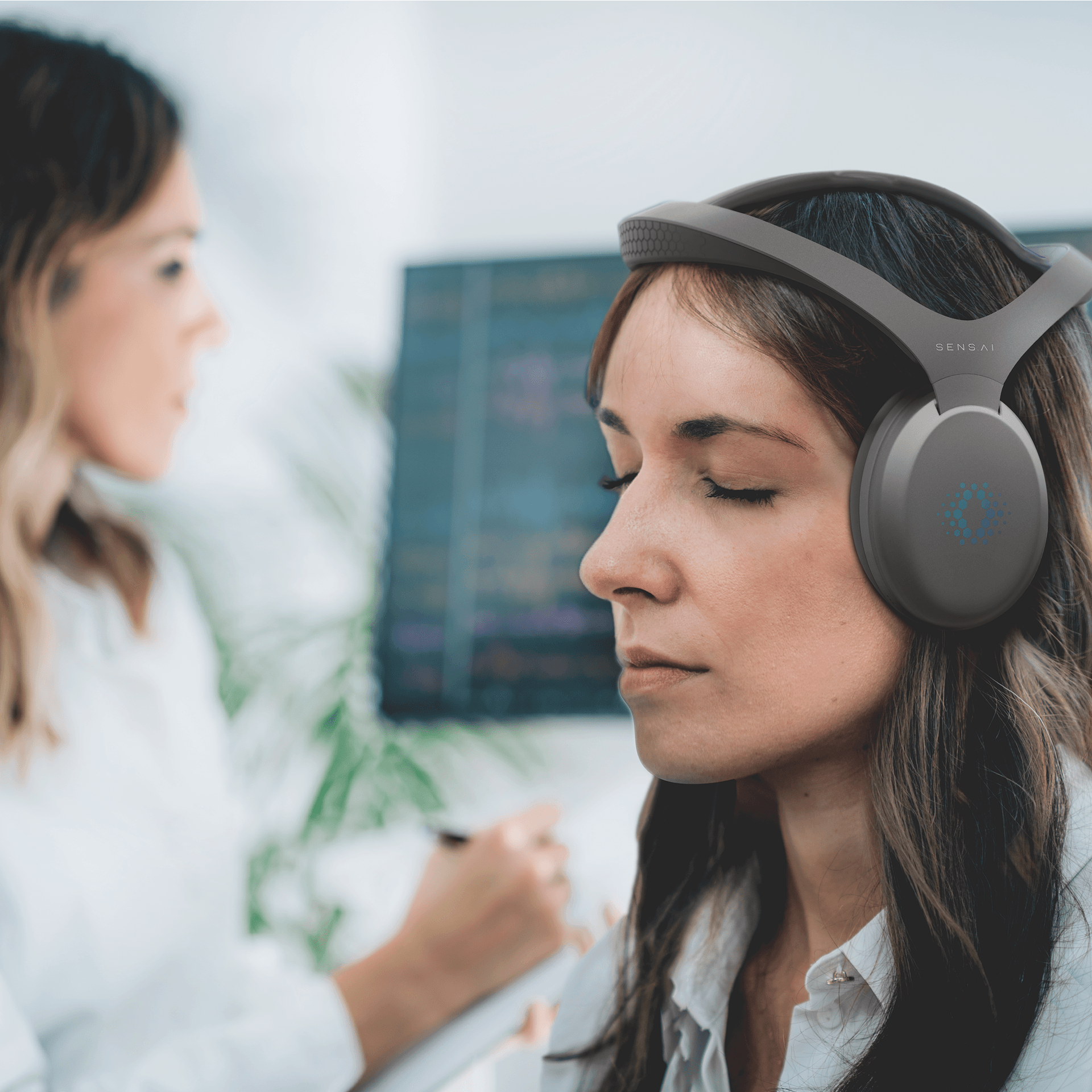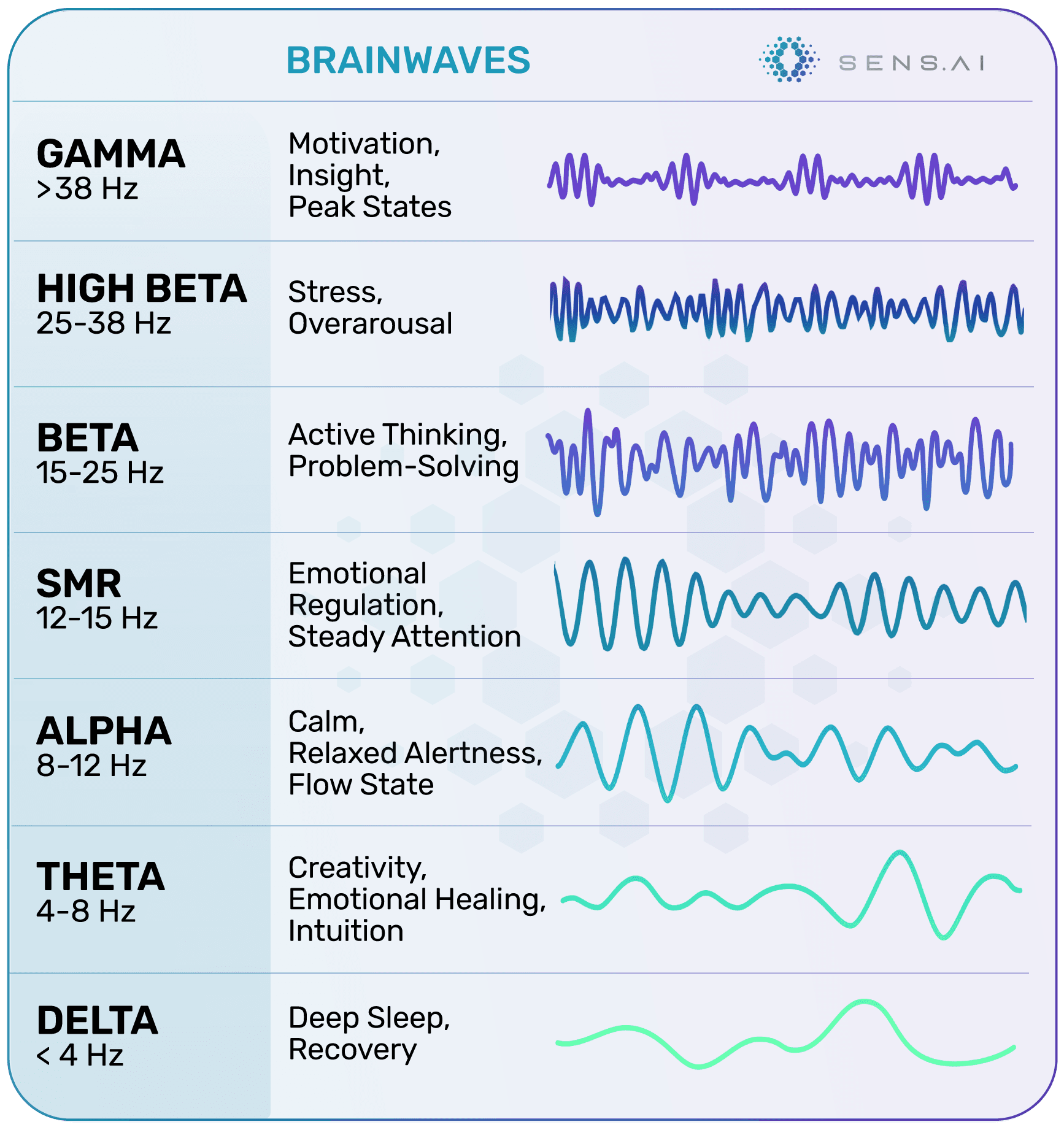MEDITATION
3 Neuro Techniques to Build Long Term Stress Resilience
Paola Telfer

Long-Term Stress Resilience: Three Neuro Techniques You Need to Know
Our society has become more aware of the negative effects of stress on our daily lives. This modern world we have created is a source of constant sensory bombardment. Many of us are turning to meditation for stress management. But meditation can be difficult when you start trying; it can be hard to know if you are meditating well, how to make consistent improvements, and if you are having genuine results. Neurotechnology offers tools for non-meditators to more easily access the benefits of meditation.
a physical, mental, or emotional factor that causes bodily or mental tension — Stress definition from MedicineNet
Stress can be defined as “a physical, mental, or emotional factor that causes bodily or mental tension.” Our biological response to stress causes a myriad of complex chemical reactions like the release of adrenaline and cortisol hormones, preparing the person to act forcibly with their muscles, to fight or flee from the perceived stressor. Stress has become a chronic condition in our society and is correlated to and causing illness. We are aware of the problem that stress is causing in our society, in a general sense. But how aware are we of the effect of our stress, on a moment-by-moment basis, within our own personal experience? And do we have and use tools to manage our stress? Unless we can manage ourselves out of a perpetual state of stress, we cannot be at peak performance - not in our professional lives nor our personal lives.
Self-Awareness is key. At Sens.ai we translate signals from the brain and heart into audiovisual cues to train self-regulation. In the sections below, we describe 3 powerful neuroscience-backed techniques to train in stress management: biofeedback-informed breathing, perception management and neurofeedback.
1. Biofeedback-Informed Breathing
Our autonomic nervous system looks after a lot of the complex functioning of the body including circulation and breathing. The breath is the wind on which our thoughts and emotions ride. Try watching your breathing patterns as you watch an action movie and notice if your breathing is slow or fast and if you hold your breath during fight scenes. The link between your breathing and your physiological state is well-studied.
In fact, breathing rate training such as resonance breathing is a known method to improve your heart rate variability (HRV), balance your physiological state and move from a sympathetic to parasympathetic nervous system (PSNS) response. The sympathetic nervous system is associated with the fight and flight response and the parasympathetic system with the rest and digest response. In this way, breathing rate training helps to reduce the physiological stress response according to several studies, including this one from the US National Library of Medicine.
Heart Rate Variability (HRV) is the physiological phenomenon of variation in the time interval between heartbeats. It is measured by the variation in the beat-to-beat interval, a known indicator of central nervous system balance. The main controllers of HRV are the sympathetic and parasympathetic nervous systems. High HRV is indicative of a flexible nervous system that is up to the task of managing stressors. Unresponsive heart rate and low HRV are indicators of an inflexible nervous system which has been correlated to post-traumatic stress disorder (PTSD), cardiovascular ailments, diabetes and other conditions.
Luckily HRV can be altered or reset with a personalized breathing pattern leading to physiological balancing. HRV biofeedback training strengthens the PSNS and is associated with a large reduction in self-reported stress.
There are many free apps that can guide you through rhythmic breathing such as BreathAir. They help you breathe deeply and help to maintain the timing of the breath. It might take a bit of experimentation to get a rate that feels comfortable; if you have no idea, 6 seconds in and 7 seconds out is a good starting point. Ideally, you should get your specific resonance breathing rate calibrated by a clinician or automated system like Sens.ai, so you know you are practicing at a rate that achieves your personal heart coherence.
Sens.ai uses a very accurate PPG (photoplethysmography) sensor to measure HRV. The Sens.ai app calibrates your resonance breathing rate and trains you for your personalized heart coherence. This helps sync up your heart rate with harmonic frequencies in your brain. Heart coherence is a consistent rhythmic heart rate pattern associated with a high-functioning parasympathetic system or PSNS. This relaxed state will help you relax and improve your brain's responsiveness to training. HRV coherence is one of the data points tracked by the Sens.ai app.
2. Perception Management
The other key part of the stress definition is that the stress factor can be originating from internal or external sources. In our society, the source is mostly of internal origin. In modern society, the proverbial predator lives in the cage with us. The key to overcoming our constant state of stress is managing our perception. That is, proactively choosing what we do, versus what we do not, label as a threat. When we label something as a threat we give it power. We let it distract our thoughts, disturb our breathing and alter our autonomic chemical response so much that our focus and peace of mind are compromised. We can choose what we give this power to. We don’t need to be victims of our circumstances; we can be creators of our reality.
Do you notice how in retrospect, when you gain some perspective, you can reflect on your past stress responses and realize that it did not serve you? It did not help you perform better or come up with more creative solutions. If we can look to manage stress to optimum levels for performance we can achieve new heights of focus, flow and creativity.
To experience changes in perception, we can choose to contemplate gratitude and forgiveness. These have been demonstrated to have favourable neurological effects and are the hallmark of top-tier brain training clinics.
Here is a powerful 20-minute mental exercise which helps with reframing your perception:
6-phase meditation by Mindvalley
3. Neurofeedback
We know that one of the most effective methods of managing and retraining our stress response is meditation. “Our nervous system does not differentiate between stimulus from our environment and imagination.” Meditation can be defined as proactively training new habits of mind with focused attention. It is an effective way of creating new physiological and mental patterns. Interestingly, this is what neurofeedback does as well.

Neurofeedback as offered by Sens.ai, is a way to make the biorhythms of your brain and heart vivid and audible. You can hear and see real-time cues representing your heart rate and brainwaves in a way that intuitively contributes to and is integrated with new thought patterns. This helps you in self-awareness and in learning self-regulation more readily.
Neurofeedback can be used on its own or it can be used to accelerate the effects of meditation. These days there are so many different meditations available even for free from apps like Calm, Headspace and Insight Timer on your phone. We have created meditation tracks inside our App that can be used during Boost Sessions.
4. A Closer Look at Brainwaves
If you are new to neurofeedback, you may be wondering about brainwaves and why we need to train them. Brainwaves are the patterns of electric pulses made by brain cells (neurons) when they communicate with each other. They are categorized into bands based on frequency as you can see in the image below. For a detailed description of each brainwave category, you can visit https://sens.ai/science/brainwaves.

Multiple frequencies, or types of brainwaves, will be present in the same brain region at the same time. Think of a large sound speaker at a concert. When you look at it closely or touch it, it is vibrating intensely. Is it producing one sound? No, of course not. There are several sounds coming through the same medium at the same time. Your brain works in the same way - multiple brainwaves are present at the same location at the same time.
Having too much or too little power in each waveband can be a problem, and depends on the situation and task. You want lots of delta while in deep sleep, but not that much delta while awake and tasking. So the ability of the brain to be flexible and produce more or less of each band depending on the requirements of the moment is key. That is why each band is associated with both negative and positive characteristics. If you stayed in high theta, that would be great for access during creative problem-solving or therapy but not so great in getting something done.
We are often in Beta during the waking day. It is a state that is focused externally on matter. When we are trying to predict, control and force outcomes we are in Beta. When we are ruminating and preparing for worst-case outcomes we are in Beta. Beta is a state of high alert that can reflect inefficient brain function. As we slow down our brainwaves we move from the neocortex to the midbrain and from Beta to Alpha, and even in Theta. These deeper states are where we get out of the logical mind where we often are getting in our own way. In Alpha and Theta training, we can settle into lucid states within our subconscious mind and access the operating system of the body. This has the potential to be a place of introspection, self-repair, healing and deep meditative states.
With neurofeedback, you are training your brain to amplify specific brainwave frequencies relative to others to create a dominant frequency and type of brain activity. There are clinics where you can do brain training and Sens.ai offers high-quality training for this at home. Alpha training is commonly used for stress management. If you do not have access to Alpha training tools, it can be helpful to use free online tools like binaural beats at an alpha frequency. It won’t have the same long-term efficacy as brain training, but it is often free.
DISCLAIMER
This content is for informational and educational purposes only. It is not intended to provide medical advice or to take the place of such advice or treatment from a personal physician. All readers/viewers of this content are advised to consult their doctors or qualified health professionals regarding specific health questions. Neither the author or Sens.ai, the publisher of this content takes responsibility for possible health consequences of any person or persons reading or following the information in this educational content. All viewers of this content, especially those taking prescription or over-the-counter medications, should consult their physicians before beginning any nutrition, supplement or lifestyle program.